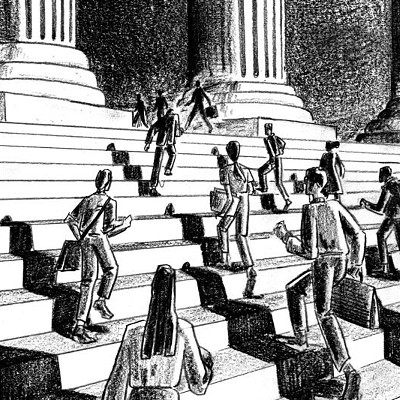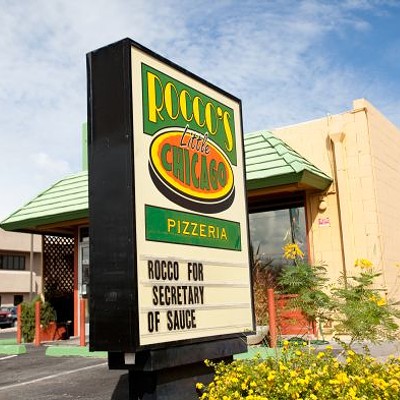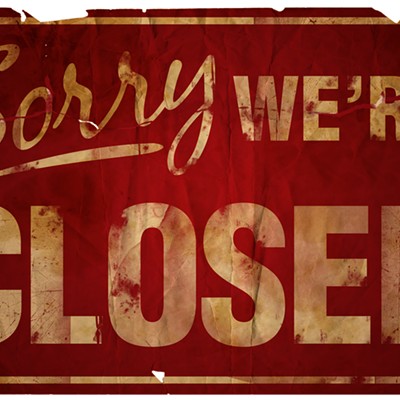At the core of the district, west of Fourth Avenue between the railroad tracks and Sixth Street, are 20 warehouses owned by the state of Arizona. These properties and others, most built 75 to 100 years ago, were acquired in the 1980s at a cost of $13 million and slated to be demolished for the downtown leg of the Barraza-Aviation Parkway.
Public criticism and rising construction expenses sidetracked those plans in 1989. The city of Tucson then assumed responsibility for planning the controversial one-mile project, now estimated to cost $120 million and take 20 years to implement in seven phases.
Six to eight of the warehouses are now slated for eventual demolition and several more are to be "impacted." In addition, a row of buildings along Toole Avenue near the Stone Avenue underpass will be left on an "island," elevated at least nine feet above the depressed roadway.
Before the state threw in the towel on the project, it leased the buildings to artists who continue to occupy them. But with an uncertain rental future, short-term leases containing 30-day cancellation clauses and costly rehabilitation efforts put on hold, many questions remain about the district's future.
The city of Tucson is now proposing to acquire almost all of the state-owned warehouses, which has artists wondering about their fates. While remaining generally optimistic, they do have concerns.
These issues--including rent rates, length of leases and maintenance and rehabilitation of the structures--were first raised by Sarah Clements, then director of the Tucson Arts District Partnership, almost four years ago. She questioned the impacts the parkway project could have on the continued viability of the warehouse district as a compact enclave of artist studios and galleries,
A few months later, the City Council responded with the "Warehouse District Vision," a series of policy statements encouraging the preservation of both art space and historic buildings while ensuring affordable rents.
In late April, the City Council is expected to discuss policy issues relating to the future of the district. If the current time schedule holds, the city will assume ownership at no charge of almost all the state-owned buildings by July 1.
John Updike of the city's Rio Nuevo office is overseeing the property transfer effort. Updike concedes he has more questions than answers at this point, but says the city may use rent payments, which total more than $300,000 a year, to offset the $1 million to $2 million cost of structural improvements to the buildings.
While current building codes may make rehabilitation of at least some of the properties extremely expensive, Updike points out the city may soon adopt new standards for historic structures. He says these proposed revisions may encourage building improvements that can be accomplished more economically.
Updike thinks some rents in the district may increase because the city will probably need to charge market rates. But he supports extending the length of leases. "What's the harm in extending the lease if we don't need the building for another five years?" he asks. "Let's be realistic about it."
The possibility of longer leases is encouraging to David Wright, board president of the Museum of Contemporary Art, which occupies three spaces near the Sixth Avenue underpass, one for more than 10 years. "If we knew we had five years more before the building was demolished, we would like to fix things like the floors and lighting," he says.
The museum, which houses about 20 artist studios along with the Hazmat Gallery, now pays no rent to the state. Wright says the organization hopes to maintain the same understanding with the city, but if rent is required, he hopes it is reasonable--no more than $1,000 a month. "It would be a hardship for us but we would figure out some way to cover it," he says. "But if the amount is significantly more, it could be a fatal blow to the organization."
Figure sculptor Steven Eye, who has occupied his studio and community gallery near the Stone Avenue underpass for the past 14 years, also expresses concerns about rent increases. He currently pays $375 a month for 3,000 square feet of space. "Full market value rent would kill us," he says.
Despite that, Eye is optimistic about the city acquisition of the properties and the potential for fixing them up because he sees a bright future for the warehouse district. "It's a great treasure and all the city has to do is sit back and let it happen," he says.
David Aguirre, local artist and director of a cooperative that includes 50 studios, agrees. "The Rio Nuevo project and the warehouse district can complement each other," he says. "We need to be collaborative instead of combative."
But Aguirre expresses opposition to the city's plans to demolish the historic Citizen Transfer building on west Sixth Street, which he manages. "Implementing the proposed roadway doesn't justify tearing down the building," he says, "especially because they only need a few feet off the front. I'm sure there are other options."
Updike hopes to meet with tenants of the state-owned warehouses before the issue is presented to City Council in a few weeks. The Museum of Contemporary Art's Wright believes that meeting is important, but understands that questions may outnumber answers. Nevertheless, he says, "A big change is coming up for us, and it could be a good thing."












